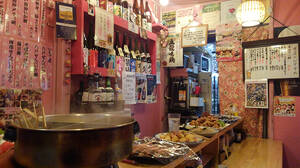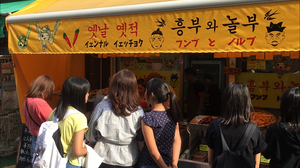Center for Asia Pacific Studies
The Center is San Francisco’s academic gateway to the Asia Pacific, fostering and promoting innovative research, teaching and public programs.
We are pleased to announce the publication of the latest issue of Asia Pacific Perspectives. In vol. 16, no. 2 (2020), we present the multifaceted ways in which scholars in the humanities and social sciences are looking at food and culture in the Asia Pacific. Beyond satisfying our curiosity about food trends and consumption patterns both past and present, our latest issue also considers themes important for our understanding of East Asia during the 20th and 21st centuries including global modernity, imperialism, the history of food in East Asia, the history of animal health, cultural appropriation, indigenization, and more.

Researching what ordinary people ate in the past is like trying to scratch an itchy foot through a shoe, according to cultural geographer Arizono Shōichirō who studied the diet of the peasants in early modern (1600-1868) Japan. His exasperation stemmed from the fact that there are no primary records describing precisely what ordinary people ate on a daily basis in the early modern period. This essay examines a few “known unknowns” in Japanese food history as a way of sketching where some of the boundaries of knowledge end and where supposition begins. My narrative examines three topics: sake, recipes, and restaurants and the prevalence of meat consumption in premodern Japan (before 1868) to show that sometimes trying to explain an absence presumes that absence.

Most outsiders come to Osaka’s Koreatown to experience a bit of the Korean wave: K-pop, Korean dramas and a burgeoning food culture emanating from South Korea. Today, few Japanese consumers need to make the trip to this ethnic neighborhood as grilled meat, kimchi and savory pancakes are readily available outside these cultural enclaves in the frozen food aisles of grocery stores or popular restaurant chains. Although these specialties emerged in places like Tsuruhashi, they have become an integral part of the Japanese foodscape and are now considered by many to be native to the island nation. What process enabled the domestication of Korean food in Japan and why is this issue relevant to contemporary Korean residents in Japan?
The Philippines remains largely distinct in the Asia Pacific and, indeed, around the world when it comes to the uniqueness of its culinary heritage and the practices and traditions surrounding local food production and consumption. Within the last two decades or so the Philippines has attracted a global focus to what it has to offer in terms of its viable food culture. Photos in this essay — taken from 2005 onwards — speak to processes of indigenization that transform and tweak global products to fit the distinct parameters of traditional Filipino palates wherein the sweet and succulent enjoy a privileged position above zesty or dry tastes. Snapped in and around Dagupan City, Pangasinan, as a part of my ongoing ethnographic fieldwork there, these images vividly illustrate the sorts of processed foods and convenience cuisine now equally situated alongside inexpensive street snacks and marketplace fare that collectively comprised ordinary Filipino diets during the 21st century’s first two decades.

Although globalization has allowed science and technology to reach every corner of the world, many contemporary Chinese people still tend to follow Traditional Chinese Medicine’s (TCM) principles of self-care in their daily lives. This traditional discipline, as a foundational worldview for its people, has existed in China for more than 2,000 years and still seems to continually influence contemporary society. This paper will examine the impact of TCM on young Chinese people’s understandings of self-care by examining their preferences and eating habits, especially among those who have lived and studied abroad for a significant period of time.
During China’s Republican Era (1912-1949), soy milk was reformulated from a commonplace locally-made drink to a factory-made, scientifically fortified—and therefore modern—dietary choice. In The Other Milk: Reinventing Soy in Republican China, Jia-Chen Fu assembles a comprehensive historical record of the scientific, commercial, and government discourse on soy milk from the 1920s-40s. It includes personal accounts of a New York born-and-raised Chinese food security activist, commercial advertisements from a Canadian-Chinese doctor marketing his soy-based baby formula, excerpts from an agricultural journal translated from Japanese and disseminated across China’s district offices, as well as photographs from local newspapers. These sources illustrate China’s rising hopes for nation-building and modernization through a dietary lens.